INTRODUCTION
Our entire world’s operations are extensively reliant on energy resources. However, their scarcity is often overlooked. This has stimulated a worldwide energy challenge and encouraged many to converge toward alternative energy sources for a better tomorrow. Photovoltaic Technology is a sustainable and eco-friendly technology advancing to make a difference in the renewable energy industry. The sun’s radiation is said to have enormous potential in terms of energy output. Due to this very fact, photovoltaic systems have been developed to produce electric power by utilizing solar cells to transmute energy obtained from the sun to a flow of electrons using the photovoltaic effect.

With increasing photovoltaic plants and solar farms, the obligation to sustain their productivity in a cost-efficient and timely fashion has become a priority. Solar panel inspections are now backed with revolutionary Drone Survey Technology, visual and thermal aerial inspections , aerial infrared imaging, etc. Drone surveys in large photovoltaic plants have proven to be significantly valuable. Drone-powered solutions have granted practical, trustworthy, and high-resolution data, empowering PV systems to improve their operational efficiency. Along with drone-powered solutions, the renewable energy sector is not just sustainable but also unstoppable.
MARKET POTENTIAL
From the period between 1992 and 2018, the overall development of photovoltaic systems worldwide has been awe-inspiring. Remodeling from a modest market of applications to maturing into a mainstream electricity element, this renewable energy source supports countries across the globe. Twenty-eight countries of the European Union were said to have grown by a whopping 81% in 2019 regarding photovoltaic systems installations. Investments and R & D for such sustainable energy resources are at an all-time high and continue to grow as we see it.
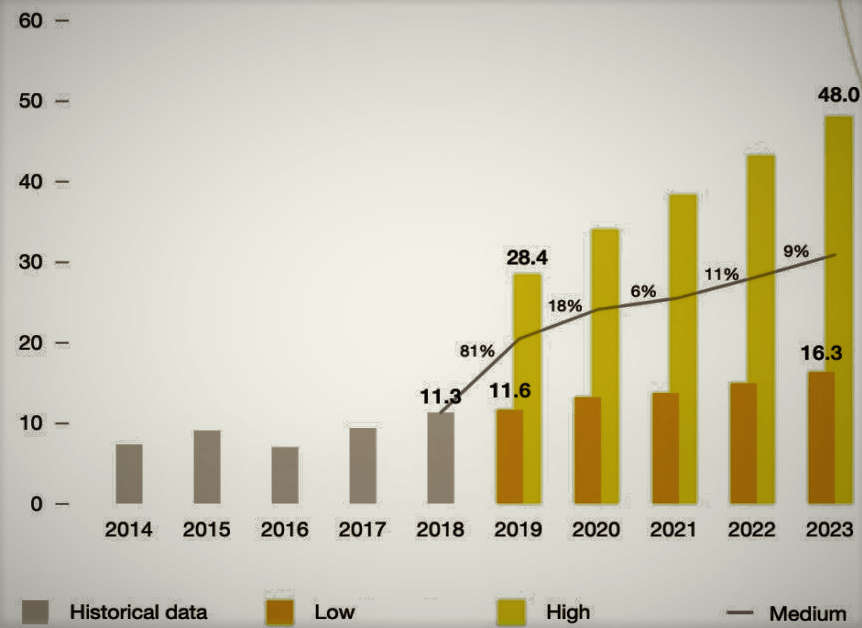
Under the statistics furnished during a DJI webinar, nations such as Germany, Spain, France, Italy, and the Netherlands endeavor to produce more than 75% of all European photovoltaic energy by 2023.
To secure the advantage of the photovoltaic effect, all components installed must be thoroughly inspected and monitored. PV installations are fixed on the ground, rooftop, wall, or even left floating. However, these components are observed to warrant efficiency and safety through drone technology. Defected solar cells can diminish output and even damage other solar panel elements, generating enormous losses for the owner.
By employing drones in the renewable energy sector, firms can preserve their assets’ goodwill and sustain energy output through timely and precise solar panel inspections. UAV Technology on-site yields valid, real-time, and cost-efficient inspection data instantly.
MANUAL VS DRONE INSPECTION

Although with the rise of solar panel inspections, diverse inspections are still manually executed, using handheld thermal cameras. Thermal cameras are popular because they can explicitly recognize any manufacturing defects, cracks, faulty components, faulty bypass-diodes, or even temporary shadowing on solar panels. Handheld monitoring is adequate; however, the approach can be made more efficient by fostering drone technology for solar farms inspections. By relying on drone imagery, users are guaranteed an enhanced quality of data, increased safety, and is time-efficiency. The following dimensions are why drones powered solutions are more reliable inspection methods than conventional/handheld procedures:
- Increased efficiency – Unmanned Aerial Vehicles (UAVs) acquire data almost 50x (times) quicker than other manual processes, making them extremely economical. Since solar farms are generally established on extended properties, drones furnished with thermal and RGB sensors can effectively cover more land to recognize defects than manual procedures. Thermal mapping and RGB sensors present a comprehensive outlook to businesses during solar plant inspections, which handheld mapping does not offer.
- Improved Quality & Volume of Data –Drone Technology is often backed with Artificial Intelligence and Machine Learning. Aerial inspections fulfill tasks precisely and don’t overlook problems that manual processes might. The method of collecting drone imagery can be replicated every time required. Since drones cover more areas, advanced technology allows large quantities of information to be seized while maintaining the data’s essence.
- Avoiding dangerous working hours – Drone inspections cater to a safer surveying and monitoring environment at solar farms. They overcome the necessity of having to endanger worker safety to fulfill maintenance operations.
- Reduced costs – UAV Technology assures that inspection costs, maintenance costs, equipment costs, and even potential shut-downs are lowered through the novel method. Conserving the quality of the asset, firms can secure the solar farm’s productivity and energy output. With the combination of thermal mapping and RGB sensors, defects can be identified and resolved in their early stages.
- Store, track & distribute data – Drone data can be stored on guarded portals for future references and convenient, timely reporting. The data can be accessed through various devices for further interpretations whenever needed. Trends in the data can also be established for in-depth future decision making.
You may also like
How UAV and Drone Technology is Influencing Mining Operation
TYPES OF DEFECTS

PV defects are described as components of the photovoltaic system that aren’t perfect or up-to-par. A PV defect is different from a PV failure since it doesn’t result in safety hazards or losses usually. A few common defects recognized during solar farm inspections are as follows;
- Cell Mismatch Defect –A cell mismatch transpires when the cells embody varying physical features or function under different conditions. Photovoltaic cells work together to maximize output; thus, any cell deficiency can significantly influence the entire system and its yield. Cell mismatches and faulty bypass diodes may result in hotspots provoking browning, burns, or even a fire.
- Cracks –

CRACKS These defects are remarkably common in photovoltaic systems and occur in differing lengths and conditions during their lifetime. Soldering, stringing, and handling during manufacturing, packaging, transport, and reloading during finishing, and unfavorable climates with strong winds, snow, and hail can produce cracks in PV modules.
- Discolorations –
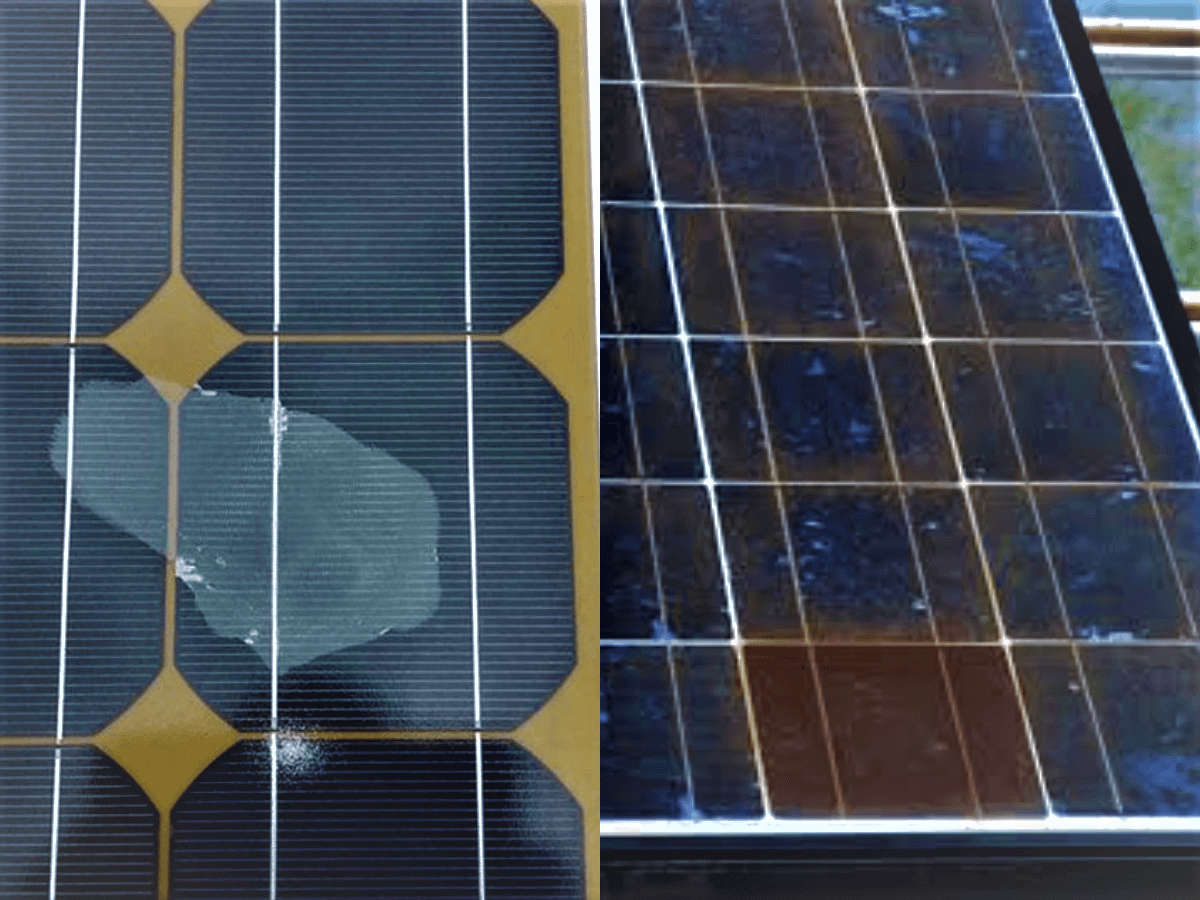
DISCOLORATION Discolorations of PV systems can be prompted due to internal components such as utilizing low-quality polymers for cell assembly, or external factors like scorching temperatures and humidity. These defects diminish the amount of sunlight entering PV cells due to which they generate significant losses.
- Delaminations –

DELAMINATION Through a PV modules’ lifetime, adhesive bonds between solar cells’ materials can begin to hold moisture, causing severe delaminations. These defects can also occur due to improper lamination methods and harsh weather conditions.
- Hotspots –
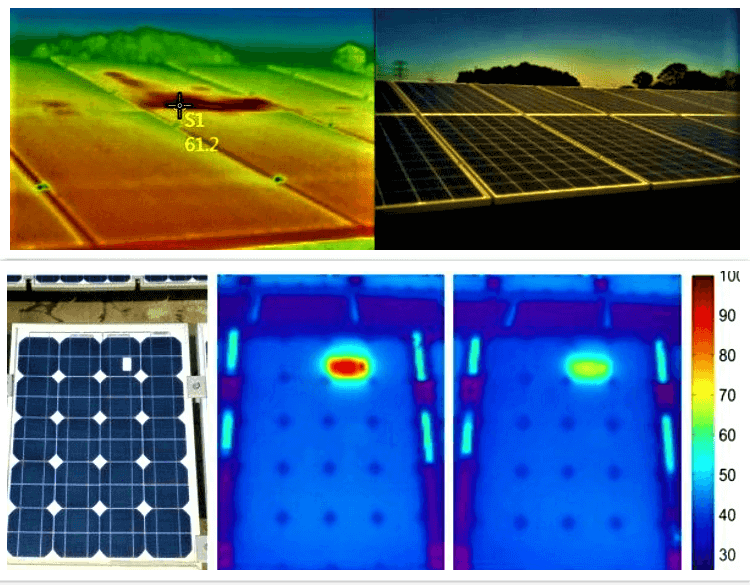
HOTSPOTS These are regions on the solar panel that are overloaded, due to which they become warm. These can be generated because of poorly soldered cell connections or even structural flaws in solar cells. Inadequate soldered connections decrease the resistance in segments that receive the power rendered by cells. This resistance leads to an increased voltage, forming a hotspot in the soldered cell. Hotspots can result in short-circuits and can also depreciate the productivity and goodwill of the PV system.
INSPECTION TECHNIQUES
Common inspection techniques for solar plant inspections include-
- Visual Inspection – This inspection technique is utilized initially to ensure that PV systems are fit to function. When PV systems pass this inspection method, they are processed through others. Visual surveying can successfully discover defects like soiling, cracks, discolorations, delaminations, and even snail trails on solar panels.
- Electroluminescence – Photovoltaic systems generate electric power by using solar cells to convert energy from the sun to electrons’ flow. Therefore, it can be said that PV systems transmit photons after being stimulated, which is the principle of electroluminescence. This technique is performed by utilizing direct current on the module and mapping photo emissions with an infrared camera. This technique must be implemented in dark conditions to detect damages precisely. The dark areas mirror sections with various damages, whereas the bright clear areas are sound and free of defects. For example, electroluminescence would distinguish damages like cracks as dark lines.
Though this procedure is beneficial, it does come with its set of disadvantages. Solar plant inspections cannot be conducted while they are operating, thus, increasing downtime. Electroluminescence also demands large volumes of power supply and yields a qualitative diagnosis only. - Infrared Thermography –
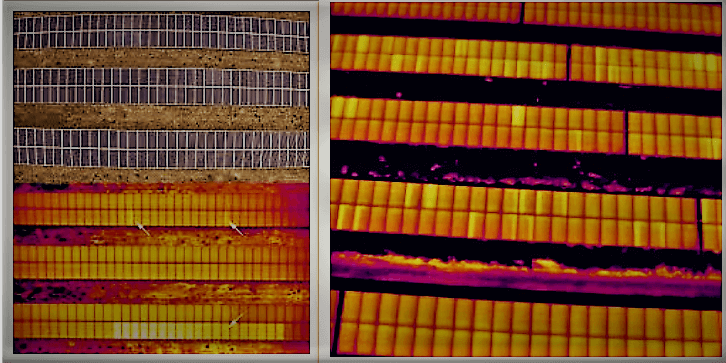
THERMAL IMAGE OF SOLAR PANEL Any temperature that exceeds the absolute zero temperature emits heat radiation in the form of electromagnetic waves in proportion to their body temperature. Thermal cameras can seize this radiation, transform it into an electric signal, and produce thermograms wherein each pixel comprises temperature values. Thermal cameras bear two kinds of detectors; incident IR radiation and photonic/quantum detectors. Among the two, incident IR radiation associates at a molecular level with the panel materials, unlike quantum detectors. In Photovoltaic systems, thermal sensors such as microbolometer detectors are frequently utilized.
With the support of Infrared Imagery, quantitative data representing specific temperature values and qualitative data portraying temperatures contrasted to other examined elements can be obtained.
Procedural, technical, and environmental variations can influence IR thermography measurements. A specialist in the appropriate field must be present to inspect precisely using this technique. This method also depends on the IR camera’s specifications, the distance between the object being investigated, and the surface’s corresponding power to emit heat by radiation (emissivity). External factors, such as unfavorable weather conditions with humidity, rain, wind, etc., can significantly influence measurements as well.
This inspection technique is non-destructive, requires zero contact, acquires data quickly, and can inspect solar farms on a large scale!
DRONE INSPECTION (techniques) USING RGB AND THERMAL INFRARED IMAGERY
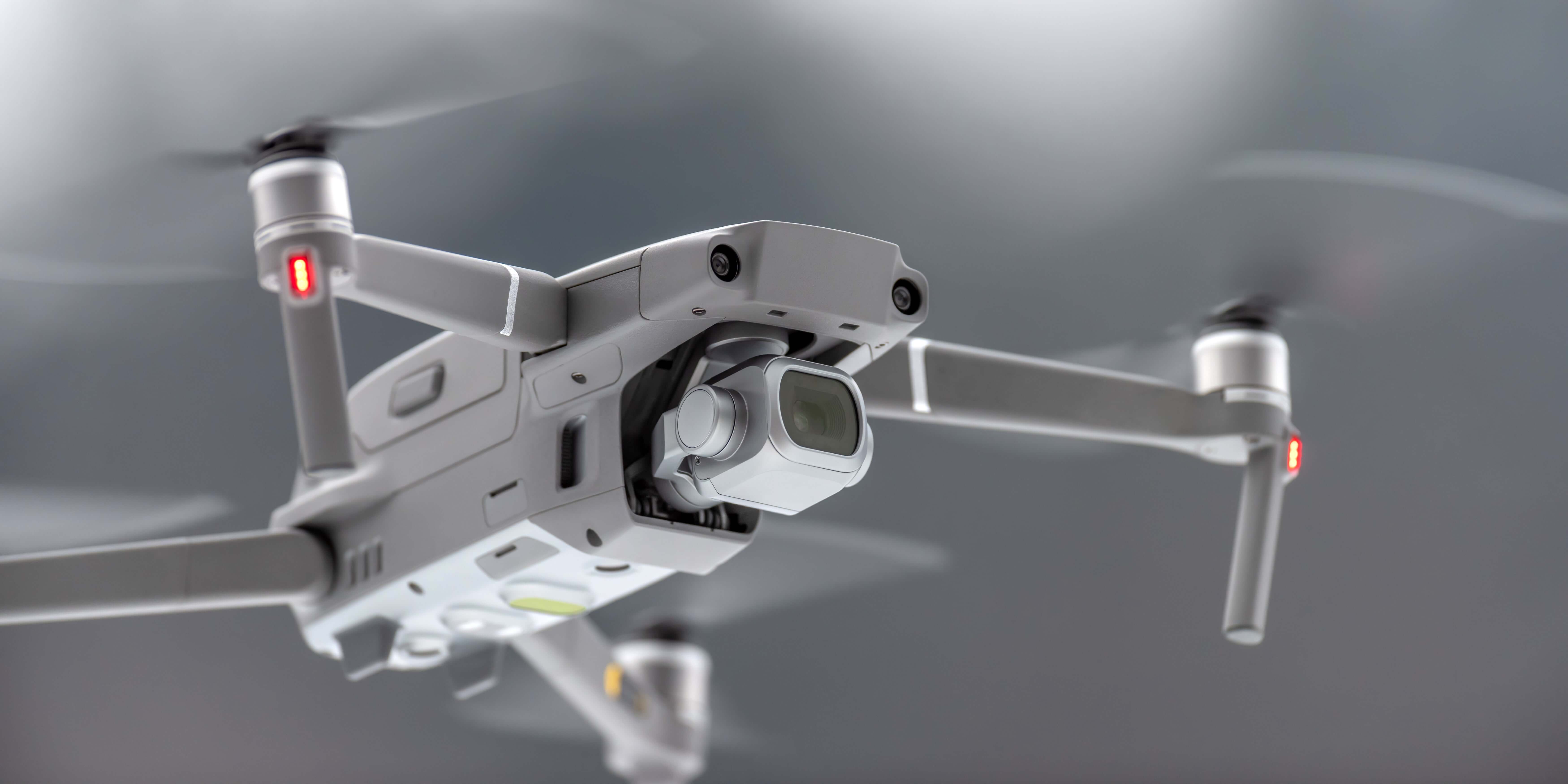
Viewing UAVs’ capabilities and the disadvantages of manual inspection techniques, drones can be declared a natural fit for solar farm inspections. The utilization of Drone Technology has developed rapidly in the renewable energy industry. Drones furnished with thermal cameras can operate and capture accurate thermal imagery along with geospatial metadata. Traditional visual and thermal inspection can be replaced with functional aerial infrared imaging.
For practical drone-powered solutions for photovoltaic systems, several conditions regarding specifications of cameras, sensors, and other elements must be met. For example, in RGB imagery, requirements like capturing aerial images vertically with a tilt optionally less than 3°, if followed, would yield meaningful data. Strong winds and other unfavorable conditions can significantly hinder stability and solar ray reflections, reshaping an RGB inspections’ quality.
For thermal inspections, suggestions include utilizing a thermal camera with sensitivity in the 8–14μm band and favored thermal sensitivity below 0.08K to identify minute temperature variations, adequate solar irradiance for an appropriate thermal contrast (between 500W/m2 and 700W/m2), a viewing angle of 5° to 60° for the thermal camera’s positioning, and no airflows. Operating UAVs early morning or in the evening to bypass unwanted reflections on the panel’s surface and any shadowing from drones is also suggested.
With precise visual monitoring systems and RGB imagery, users can comprehensively recognize defects, like cracks, delaminations, soiling, discolorations, and even panel corrosion.

